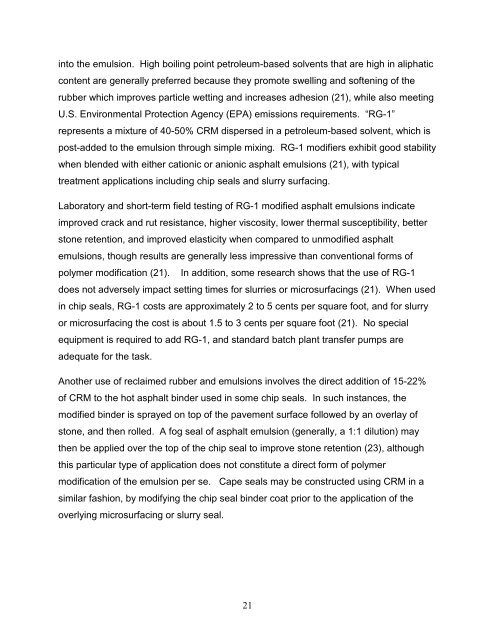Using Polymer Modified Asphalt Emulsions in Surface Treatments A ...
Using Polymer Modified Asphalt Emulsions in Surface Treatments A ...
Using Polymer Modified Asphalt Emulsions in Surface Treatments A ...
Create successful ePaper yourself
Turn your PDF publications into a flip-book with our unique Google optimized e-Paper software.
<strong>in</strong>to the emulsion. High boil<strong>in</strong>g po<strong>in</strong>t petroleum-based solvents that are high <strong>in</strong> aliphatic<br />
content are generally preferred because they promote swell<strong>in</strong>g and soften<strong>in</strong>g of the<br />
rubber which improves particle wett<strong>in</strong>g and <strong>in</strong>creases adhesion (21), while also meet<strong>in</strong>g<br />
U.S. Environmental Protection Agency (EPA) emissions requirements. “RG-1”<br />
represents a mixture of 40-50% CRM dispersed <strong>in</strong> a petroleum-based solvent, which is<br />
post-added to the emulsion through simple mix<strong>in</strong>g. RG-1 modifiers exhibit good stability<br />
when blended with either cationic or anionic asphalt emulsions (21), with typical<br />
treatment applications <strong>in</strong>clud<strong>in</strong>g chip seals and slurry surfac<strong>in</strong>g.<br />
Laboratory and short-term field test<strong>in</strong>g of RG-1 modified asphalt emulsions <strong>in</strong>dicate<br />
improved crack and rut resistance, higher viscosity, lower thermal susceptibility, better<br />
stone retention, and improved elasticity when compared to unmodified asphalt<br />
emulsions, though results are generally less impressive than conventional forms of<br />
polymer modification (21). In addition, some research shows that the use of RG-1<br />
does not adversely impact sett<strong>in</strong>g times for slurries or microsurfac<strong>in</strong>gs (21). When used<br />
<strong>in</strong> chip seals, RG-1 costs are approximately 2 to 5 cents per square foot, and for slurry<br />
or microsurfac<strong>in</strong>g the cost is about 1.5 to 3 cents per square foot (21). No special<br />
equipment is required to add RG-1, and standard batch plant transfer pumps are<br />
adequate for the task.<br />
Another use of reclaimed rubber and emulsions <strong>in</strong>volves the direct addition of 15-22%<br />
of CRM to the hot asphalt b<strong>in</strong>der used <strong>in</strong> some chip seals. In such <strong>in</strong>stances, the<br />
modified b<strong>in</strong>der is sprayed on top of the pavement surface followed by an overlay of<br />
stone, and then rolled. A fog seal of asphalt emulsion (generally, a 1:1 dilution) may<br />
then be applied over the top of the chip seal to improve stone retention (23), although<br />
this particular type of application does not constitute a direct form of polymer<br />
modification of the emulsion per se. Cape seals may be constructed us<strong>in</strong>g CRM <strong>in</strong> a<br />
similar fashion, by modify<strong>in</strong>g the chip seal b<strong>in</strong>der coat prior to the application of the<br />
overly<strong>in</strong>g microsurfac<strong>in</strong>g or slurry seal.<br />
21
















